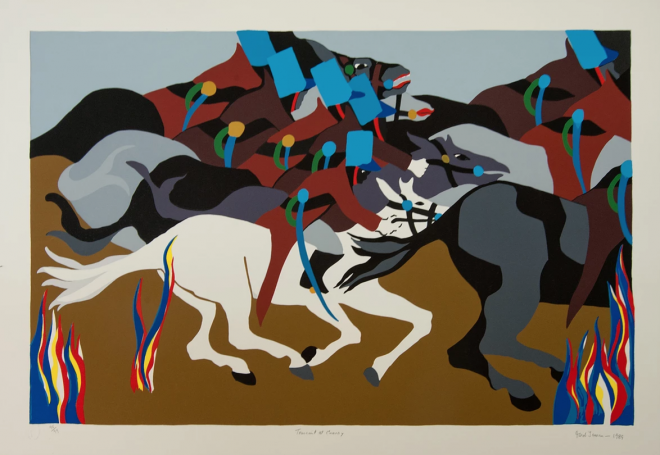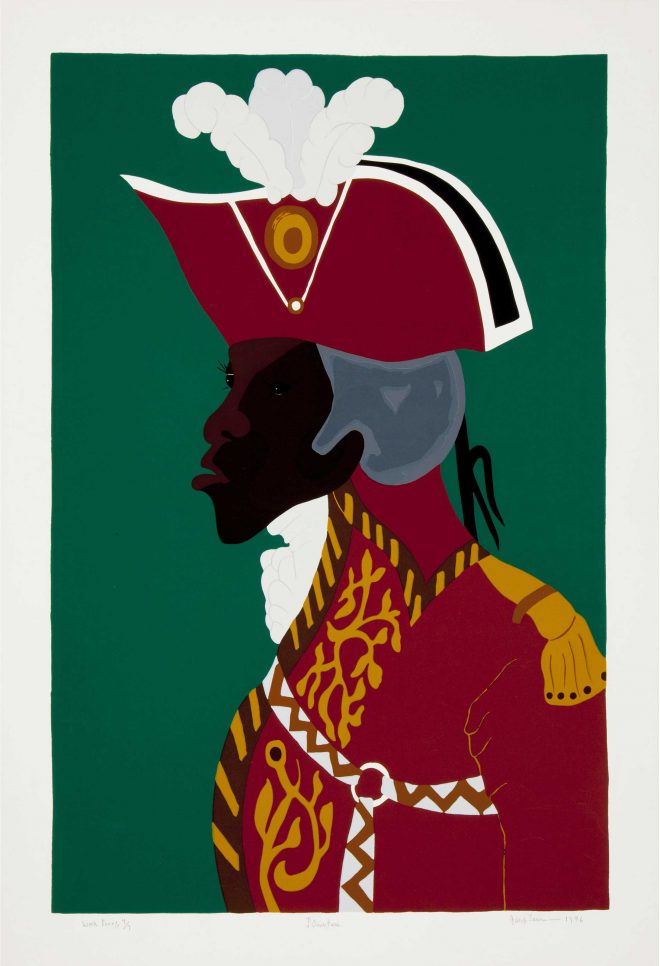Stoic and Heroic: The Amistad Research Center Celebrates Jacob Lawrence
Denise Frazier visits the Amistad Research Center’s exhibition of Jacob Lawrence’s silkscreen prints depicting scenes from the Haitian Revolution.

Jacob Lawrence, Toussaint at Ennery, 1989. Silkscreen on rag paper.
Earlier this month, many in this country commemorated the heroes of the American Revolution with fireworks and family cookouts. But that late 18th-century anti-Loyalist revolt was not the only one in the Americas that shifted the course of world history. Less than a decade after the end of the American Revolution, on the small island of Hispaniola, the enslaved Africans of Saint-Domingue revolted against French colonialism and sparked a revolution of significant economic, migratory, and social impact. A wave of African-descended people and white French planters escaped to southern Louisiana from Saint-Domingue, which was changing into the first free black republic, Haiti.
The Amistad Research Center’s choice to exhibit Jacob Lawrence’s Toussaint L’Ouverture series in its latest exhibition, “To Preserve Their Freedom,” on view for the centenary of the artist’s birth, begs the questions of how we create narratives and imagine our leaders. Formerly enslaved, L’Ouverture rose through the ranks to be one of the most successful and revered commanders of the Haitian Revolution, and, in 1801, L’Ouverture ruled Saint-Domingue as a de facto independent state before he was captured and imprisoned by Napoleon Bonaparte’s brother-in-law, Charles Emmanuel Leclerc.
Lawrence, a New Jersey native, moved to New York during the dynamic Harlem Renaissance of the early 20th century and understood that the unique history of the African diaspora needed to be told artistically. Later, Lawrence would also be a Rosenwald grant recipient. From 1928 to 1948, Chicago businessman and philanthropist Julius Rosenwald awarded stipends to African-American artists and writers interested in using their work to discuss race relations. Incidentally, Rosenwald’s daughter-in-law Edith Stern and her husband, Edgar Stern, lived in what is now Longue Vue House and Gardens in New Orleans, one connection between Lawrence and the city.
Amistad reference archivist Chianta Dorsey explains that the carefully curated exhibition—which also includes related literature on the Haitian Revolution, including Aimé Césaire’s The Tragedy of King Christophe—contains pieces the Center received as one of Lawrence’s many philanthropic projects. In Dorsey’s words, “Lawrence, from what I read, contributed art to cultural institutions. He believed in the mission of the Amistad Research Center and liked the fact that he was preserving African-American history. It was the basis of his paintings of people of African descent.”

Jacob Lawrence, General Toussaint L’Ouverture, 1986. Silkscreen on rag paper.
And people of African descent were indeed Lawrence’s subjects of choice. In 1937, at 20 years old and living in Harlem on the heels of the Great Depression, Lawrence began this series of work, which includes 41 painted panels commemorating the Haitian Revolution. Three years later, he went on to create his canonical 60-panel The Migration Series, 1940–41. Both series represent pivotal moments of swift change for two distinct groups of African-descended people, the Haitian Revolution and the Great Migration in the United States.
The Toussaint L’Ouverture series was created when Lawrence was a young man, and much later, in the 1980s and ’90s, he decided to change certain aspects of the work when adapting his original paintings to sets of silkscreen prints. The translation of these paintings into prints enabled his work to be printed en masse and distributed to a wider audience. According to Dorsey, “The serigraphs were completed when Lawrence was much older. It had been fifty years since he painted the original series. He implemented new characteristics in the work, and basically made new work.” One of the works on display is Contemplation, 1993, which depicts L’Ouverture with a book at his desk, and many of the colors in this serigraph were not in the original work. Lawrence, perhaps, felt more at liberty to add color to the more subtle parts of the print. However, the freedom to add was tempered by the need to create a cohesive narrative. Lawrence reduced the number of tableaux from 41 to 15 prints, and each print on view contains an accompanied caption to describe each scene.
One of the most striking serigraphs in the series is Toussaint at Ennery, 1989. L’Ouverture invaded the district of Ennery in Haiti, and his troops, shown with blue hats, are juxtaposed against dark-red and earth-toned coats that are accented mid-waist by buttons and cutlasses. The wide-eyed grey horse with bared-teeth displays a ferocity and incites an excitement that is further accentuated by the forward-leaning motion of the riders and the bend of the front white horse in mid-gallop. The blue, red, white, and yellow spurts of fire subtly evoke the flag colors of the new Republic of Haiti and add to the romanticism of the narrative. The mostly muted primary colors combined with the flat abstracted forms help to tell the dynamic history of insurrection. The continuity of form and color in the artist’s style also helps to offer a cohesive storyline.
When I toured the exhibition with Dorsey, she paused at her favorite work in the series, General Toussaint L’Ouverture, 1986: In full military regalia, L’Ouverture turns his profile slightly for the viewer to see a small pair of eyes, a sharp chin, and the pop of a white ruffled collar highlighting the long neck of the commander. “All we have is the story, Lawrence’s creation. I think this is a great artistic creation of L’Ouverture, because it is what I imagine him to be.”
Editor's Note
“To Preserve Their Freedom: Jacob Lawrence’s Toussaint L’Ouverture Serigraph Series” is on view through August 31, 2017, at the Amistad Research Center at Tulane University.



